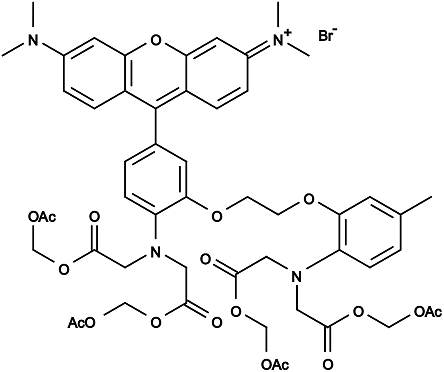All AbMole products are for research use only, cannot be used for human consumption.

Rhod-2 AM is a fluorescent, mitochondrial probe (λex=552 nm, λem=581 nm). Rhod-2 AM is cell-permeable version of Rhod-2. The long-wavelength Rhod-2 Ca2+ indicators are valuable alternatives to Fluo-3 for experiments in cells and tissues that have high levels of autofluorescence. Fluorescent probes that show spectral responses upon binding Ca2+ have enabled researchers to investigate changes in intracellular free Ca2+ concentrations by using fluorescence microscopy, flow cytometry, fluorescence spectroscopy and fluorescence microplate readers.

Exp Neurol. 2024 May 3.
Mfn2 regulates mitochondria and mitochondria-associated endoplasmic reticulum membrane function in neurodegeneration induced by repeated sevoflurane exposure
Rhod-2 AM purchased from AbMole
| Molecular Weight | 1123.96 |
| Formula | C52H59BrN4O |
| CAS Number | 145037-81-6 |
| Solubility (25°C) | DMSO 1~5mM |
| Storage | -20°C, protect from light, dry, sealed |
| Related Fluorescent Dye Products |
|---|
| DASPEI
DASPEI is a cationic styrenyl mitochondrial dye. DASPEI has excitation and emission wavelength at 550/573 nm, which has good light chromogenic property. DASPEI can stain mitochondria in living cells with good labeling property. DASPEI can also be used to stain presynaptic nerve endings independently of neuronal activity. |
| Zinquin ethyl ester
Zinquin ethyl ester is a fluorescent probe of cytosolic zinc ion. Zinquin ethyl ester is able to penetrate cell membranes and is lipophilic and zinc-sensitive. Zinquin ethyl ester can combine with Zn2+ in the cell to produce blue fluorescence. |
| HKOH-1r
HKOH-1r is a highly sensitive green fluorescent probe for the specific detection of ·OH in living cells with a maximum excitation wavelength and emission wavelength of 500 nm and 520 nm, respectively. |
| ATP-Red 1
ATP-Red 1 is a multisite-binding switchable fluorescent probe, and it can selectively and rapidly responds to intracellular concentrations of ATP in living cells. Live-cell imaging indicated that ATP-Red 1 mainly localized to mitochondria with good biocompatibility and membrane penetration. ATP-Red 1 is a useful tool for investigating ATP-relevant biological processes. |
| (±)-ANAP hydrochloride
(±)-ANAP hydrochloride is the amino acid analog of prodan, acts as a fluorescent probes, and enhances environmental sensitivity with comparable or increased brightness. (±)-ANAP hydrochloride is sensitive to polarity with changes in intensity and emission wavelength. |
All AbMole products are for research use only, cannot be used for human consumption or veterinary use. We do not provide products or services to individuals. Please comply with the intended use and do not use AbMole products for any other purpose.


Products are for research use only. Not for human use. We do not sell to patients.
© Copyright 2010-2024 AbMole BioScience. All Rights Reserved.
